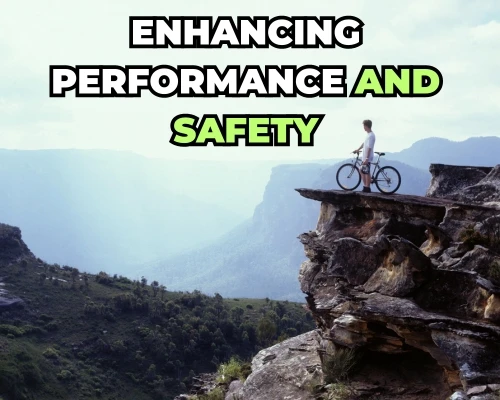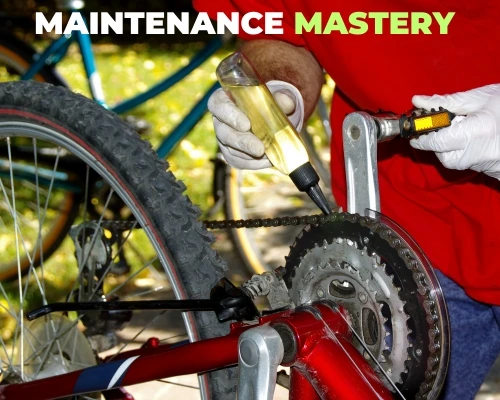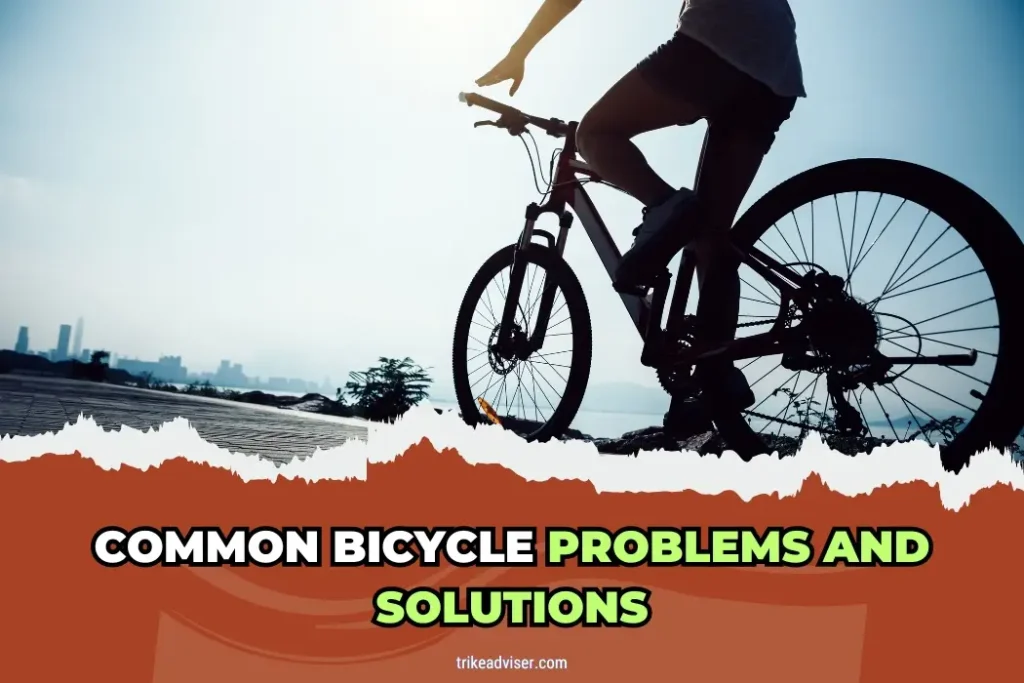Punctures on a Peaceful Ride? Every cyclist has faced this unwelcome surprise. Just picture it: a serene ride turns sour. But wait, you can’t picture it. My bad. A serene ride turns sour, nonetheless. Then, there’s the dreaded gear slip.
Mid-hill, your chain decides it’s had enough. And brakes? They squeal louder than a banshee in a library. Let’s not even start on the mystery of the ever-loosening bolts. These problems seem as inevitable as the setting sun. Yet, the solutions are simpler than you might think.
With a few tools and some know-how, peace returns to your ride. This guide isn’t just about fixes. It’s about keeping your bike silently swift and your rides smooth.
Facing these nuisances head-on means more time enjoying the journey, less time roadside. Let’s dive into the solutions. Oops, I meant, let’s jump straight in. Solutions await.
Common Bicycle Problems and Solutions
Flat Tires
Prevent Flat Tires—Check and Protect – Regular tire checks keep rides smooth. Ensure tire pressure matches recommended levels. Look for embedded objects like glass or nails. Invest in puncture-resistant tires or tire liners. These steps greatly reduce flat tire chances.
Chain Issues
Maintain Your Chain—Clean, Lubricate, Check – A smooth chain equals a smooth ride. Clean and lubricate your chain regularly. Avoid shifting under high tension. This stresses your chain. Check for wear and replace as needed. Ensure proper tension, following manufacturer’s guidelines.
Brake Problems
Brake Right—Inspect, Replace, Clean – Your safety depends on your brakes. Inspect brake pads regularly. Worn down? Replace them. Clean pads and rims to ensure peak performance. Adjust brake cables to maintain tension and efficiency.
Gear Shifting Difficulties
Shift Smoothly—Clean, Lubricate, Adjust – Difficulty shifting gears affects your ride. Keep your drivetrain clean and lubricated. This includes the chain, cassette, and derailleurs. Adjust derailleurs for seamless shifting. Learn proper techniques to avoid strain.
Loose Bolts and Nuts
Secure Your Ride—Inspect and Tighten – Loose components compromise safety. Before riding, check for loose parts. Use a torque wrench for precise tightening. Thread-locking compounds help keep critical parts secure over time.
Chain Wear and Degradation
Extend Chain Life—Measure, Replace, Maintain Chains wear down over time. Poor shifting and slippage signal wear. Use a chain wear gauge. Replace the chain if it’s beyond the wear limit. A clean, lubricated chain lasts longer.
Improper Bike Fit
Fit Your Bike—Adjust for Comfort A poor fit causes discomfort. Adjust your saddle for nearly full leg extension at the pedal stroke’s bottom. Handlebars should allow a relaxed position. A bike specialist can ensure the perfect fit.
Lack of Regular Maintenance
Keep Up With Maintenance—Inspect, Clean, Lubricate – Regular maintenance prevents problems. Inspect and clean your bike often. Pay attention to the drivetrain, brakes, and tires. Lubricate moving parts. Unsure about maintenance? A professional bike shop can help.
Enhancing Performance and Safety

Boost your ride’s performance and ensure maximum safety. With strategic upgrades and diligent checks, enhance both your bicycle’s durability and your own security.
Upgrading Your Bicycle for Performance and Durability
Wheels
Lightweight and Strong: High-quality wheels transform performance. Seek lightweight rims, durable spokes, and reliable hubs.
Impact: Better handling and durability come with these upgrades.
Tires
Advanced Grip: Choose tires for grip, low resistance, and puncture resistance. Look for reinforced sidewalls and durable compounds.
Benefits: Improved safety and efficiency on various terrains.
Drivetrain
Efficiency and Range: Upgrade for a wider gear range and lighter materials. Advanced designs make a difference.
Result: Smoother shifting and enhanced durability.
Brakes
Stopping Power: Opt for high-quality brakes for improved modulation and stopping power. Hydraulic disc and high-performance rim brakes are top choices.
Advantage: Reliable stopping in all conditions.
Suspension
Control and Comfort: Essential for off-road, look for adjustable, high-quality suspension. Air or coil springs and advanced damping matter.
Impact: Better control on rough terrains.
Cockpit
Ergonomics and Weight: Upgrade handlebars, stems, and seatposts for comfort and control. Lightweight and ergonomic designs are key.
Outcome: Improved handling and adjustability.
Safety Checks: Ensuring Your Ride is as Safe as Possible
ABC Quick Check
Air, Brakes, Cranks, Chain, and Cassette: Essential pre-ride check. Ensures vital components are in check.
Routine: Perform before every ride for peace of mind.
M Check
Comprehensive Safety: Covers all main working parts in an ‘M’ pattern. From front hub to rear.
Frequency: Regular checks keep performance and safety aligned.
Regular Maintenance
Cleaning and Lubrication: Keep components in top condition. Focus on drivetrain, brakes, and wheels.
Schedule: Routine maintenance extends component life and ensures safety.
Safety Equipment
Helmet and Visibility: Always wear a helmet. Reflective clothing and lights are must-haves for low light or traffic.
Precaution: Essential gear for protection and visibility.
Proper Fit
Custom Adjustment: Ensure bike fit is tailored to your measurements. Adjust saddle height, handlebar reach, and brake positions.
Comfort Equals Control: A well-fitted bike enhances control and safety.
Riding Skills
Skill Development: Master cornering, braking, and shifting. Practice regularly.
Confidence and Safety: Improved skills lead to safer, more enjoyable rides.
Maintenance Mastery

Mastering bike maintenance enhances your ride and extends your bike’s lifespan. Dive into a tailored schedule and the essential toolkit every cyclist should own.
Creating a Personalized Bicycle Maintenance Schedule
Regular Inspection
- Pre-Ride: Check tire pressure, chain lubrication, brakes, wheel security. Essential for safety.
- Post-Ride: Clean your bike. Prevents rust and corrosion.
Weekly Maintenance
- Safety First: Thorough inspection for cracks, loose bolts, and proper wheel alignment. Lubricate moving parts.
Monthly Maintenance
- Detailing: Lubricate jockey pulleys. Check crank and chainring bolts. Assess wheel trueness. Measure chain wear. Inspect brake pads. Tighten rack bolts.
Bi-Annual Maintenance
- In-Depth Check: Examine cables and housing. Change oil/seals in suspension. Overhaul hubs and headset.
Annual Maintenance
- Comprehensive Overhaul: Refresh ball bearing hubs, headset, and cables. Replace worn tires, brake pads, chain. Conduct a full tune-up.
Structured schedules keep bikes in peak condition, ensuring safety and pleasure in every ride.
Tools of the Trade: Essential Maintenance Kit for Every Cyclist
The Kit
Multi-Tool: Wrenches, screwdrivers, chain tools. For adjustments and repairs.
Tire Levers: For tire removal during tube replacements or repairs.
Pump or CO2 Inflator: Essential for correct tire inflation.
Chain Tool: Fixes or replaces broken chains.
Quick Links: Simplifies connecting chain links.
Hex Keys: Adjusts handlebars, stems, saddles.
Chain Lubricant: Keeps the chain smooth and efficient.
Cleaning Supplies: Brushes, degreasers, cloths. For bike cleanliness.
Suspension Pump: For bikes with air suspension. Maintains pressure.
Brake Tools: Rotor truing tools, bleed kits for hydraulic brakes, and tools for brake pad alignment.
On-the-Road Repairs

Preparedness on the road turns unexpected issues into minor hiccups. Here’s how to build your kit and tackle common problems with confidence.
Essentials of a Roadside Repair Kit
For Cyclists:
Spoke Wrench: Adjusts and tightens wheel spokes.
Small Tool Kit/Multi-Tool: Includes tire levers and chain breaker for various adjustments.
Patch Kit & Spare Tube: For puncture repairs and tube replacements.
CO2 Inflator & Cartridges: Quickly inflates tires post-repair.
Tire Levers: Essential for tire removal and installation.
Chain Lubricant: Keeps the chain running smoothly.
Cleaning Supplies: For on-the-go cleaning and lubrication.
Suspension Pump: For bikes with air suspension, ensuring correct pressure.
Brake Tools: Tools for rotor truing and brake pad adjustments.
For Drivers:
Jumper Cables: For jump-starting a battery.
Flashlight & Extra Batteries: Essential for night repairs.
Reflective Triangle/Road Flares: Increases visibility and safety.
First Aid Kit: For minor injuries.
Tire Inflator & Sealant: Quick fixes for flat tires.
Tool Kit: For various mechanical adjustments.
Gloves & Rags: Keeps hands clean and protected.
Duct Tape & Zip Ties: For temporary fixes.
Water & Snacks: Essentials for extended stops.
Cell Phone Charger: Keeps you connected.
Quick Fixes for Common Roadside Issues
For Cyclists:
Flat Tires: Use tire levers for removal, find the puncture, then patch or replace the tube.
Chain Problems: A chain breaker removes damaged links. Reconnect with a quick link.
Brake Issues: Adjust or replace brake pads using the tools in your kit.
For Drivers:
- Dead Battery: Jump-start with cables connected to another car’s battery.
- Flat Tires: Use inflator and sealant, or change the tire if necessary.
- Engine Problems: Check levels of engine oil, coolant, and fuel. Tow if needed.
Seasonal and Special Conditions Care
Riding through the seasons requires adaptation. Winter and wet conditions demand specific bike care strategies to keep you rolling safely and efficiently.
Preparing Your Bike for Winter Riding
Winter’s chill and moisture present unique challenges. Follow these steps to ensure your bike is winter-ready:
Check Tire Pressure
- Optimal Inflation: Keep tires at recommended pressure for better grip on slippery surfaces.
Chain Lubrication
- Avoid Rust: Ensure your chain is lubricated without overdoing it to prevent rust and maintain efficiency.
Safety Check
- Brakes and Wheels: Verify brakes are responsive and wheels securely fastened and aligned. Check for any loose parts.
Air Pressure in Suspension
- Suspension Care: If using air suspension, ensure proper pressure for optimal performance.
Secure Luggage for Commuters
- Stable Transport: Ensure all bags and panniers are securely attached to avoid shifts or losses.
Carry a Flat Fix Kit
- Be Prepared: Increased puncture risks in winter mean a repair kit is essential.
Clean and Store
- Post-Ride Care: Thoroughly clean and dry your bike, storing it away from corrosive elements.
Maintenance Tips for Wet and Muddy Conditions
Wet and muddy rides can accelerate wear and necessitate vigilant bike care.
Regular Inspections
- Crack Checks: Regularly inspect the frame and components for cracks, especially at connection points.
Lubrication
- Critical Points: Lubricate derailleur jockey pulleys, check and tighten crank and chainring bolts, and ensure the headset is snug without play.
Chain Wear
- Frequent Measures: Chains wear faster in wet conditions. Replace as needed to maintain drivetrain performance.
Brake Pads
- Wear Check: Inspect and replace worn brake pads to ensure effective stopping power in wet conditions.
Rack Bolts
- Secure Luggage: Tighten all rack bolts to combat loosening from vibration and load.
Suspension Care
- Forks and Shocks: Maintain correct air pressure and oil levels in your suspension system for smooth riding.
Clean and Dry
- Prevent Corrosion: After each wet outing, clean and dry your bike to protect against rust and corrosion.
As an Amazon Associate, I earn from qualifying purchases, at no additional cost to you. Read Our Affiliate Disclosure.

